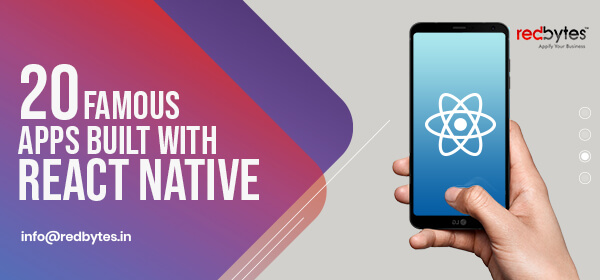React.js was originally developed by Facebook team to create a highly responsive and dynamic UI with uncompromised performance.
The react.js library was released in 2011 with an intent to leverage JavaScript speed and ability to render pages and dynamic user input. Two years later, as React.js became quite recognized, the team open-sourced React.js.
React-Native was developed and launched by Facebook team in 2015 and became quite an interesting and popular framework among mobile app developers.
It can be used for building cross-platform mobile apps. The framework was later customized by contributors to use it for building desktop apps as well.
Though React-Native looks very similar to ReactJS, there are certain differences in their use and structure. In this post, we will see a few points that separate React Native from React.js technology.
Read Also: 13 Famous Apps Built with React Native
React.js
React.js is basically a JavaScript library built to create user-friendly and responsive UI components. Also known as React, the library is responsible for the rendering of UI components in a typical technical sense. It is leveraged to support both front-end and server-side operations.

React Native
React Native is a powerful JavaScript framework used to build native applications as it compiles to React Native components. Like React JS, React Native also has the base abstractions of React DOM.
This suggests that while components are different, their syntax and workflow remain similar.
1) Setup and running process
React.js is a JavaScript Library that you can use for the web development. While starting a new project and setting up ReactJS, you will need to choose Webpack which is actually a bundler. You will then decide which bundling modules will specifically suit your project.

In React Native, you have everything you need to set up and get started. It is so easy and fast to launch the framework. All it takes is to run one command line in terminal and you are ready to start coding your first ever React native app.
You will need Xcode (for iOS) or Android Studio (for Android) installed on your computer to run the app. Use an emulator of the target platform or test its performance on your own devices.
2) Animations
Unlike React JS where CSS helps bring alive animations, React Native makes you learn entirely new ways to use JavaScript and create animations for components of your app.
With React Native, developers can animate components in the app by using the Animated API. There is quite known JavaScript library Velocity.js that you can use and compare Animated API with it.

The famous Velocity.js allows developers to form assorted animations. They work based on time and velocity of gesture and can be used in many combinations. You also have LayoutAnimation in React Native that comes off cool for transitions especially on iOS platform.
Compared to React JS that allows you to play with creative animations, React Native offers you good freedom to do a lot more in animation space.
Read Also: React Native App Development Company in UK
3) Developer tools
Rapid app development seekers would be happy to use React in their native project since you already get a few great tools without actually installing anything.
This unique quality saves a lot of time and efforts for developers. In addition, hot reloading enabled by React JS comes handy when there is a need to make small changes to overall app styles.

You can leverage Live Reload if there are bigger changes to add to the app logic so that your app reloads upon changing the code.
React Native developers can use many developer tools present in React JS. You can use Chrome Dev Tools to inspect the network requests, handle logs and for debugging.
You also have Redux DevTools for further assistance in inspection. However, the native inspector is not much helpful since you can’t inspect DOM with React Native like you are able to do on the web.
4) Business benefits of React.js
- React’s DOM (document object model) that manages data inputs and outputs is much faster than the conventional refresh model. Since it only partially refreshes certain parts of the page, Facebook never knew the process of refreshing would prove faster. By positively affecting the re-build time, the partial DOM refresh eventually boosts performance and speed while writing program.
- The phenomenon of reusable code components in React JS further saves you a lot of time.
- React.js also improves the debugging speed which highly favors developers’ work.
- The possibility of rendering the pages from the server to the browser helps positively with SEO part of your app.
- React quite easily comes to even beginners in the space. Because it is effortlessly readable, unlike other frameworks, React doesn’t require you to get thorough with an extensive list of concepts.
- Since it is based on JavaScript, developers are free to reap the maximum benefits of all the progress and updates in the Java ecosystem.
5) Business benefits of React Native
- React Native contains Native modules and components that help render certain code components directly with Native APIs to improve performance and speed. It does not depend on WebView for code rendering unlike other cross-platform frameworks.
- Since React Native also lets developers reuse code and common logic layer across iOS and Android, the need for building the applications separately for both is avoided.
- React Native offers all the mentioned benefits of React.js such as delivering a user-friendly UI.
- The component-based development model of React Native framework creates an agile web-style approach for developers to build apps without actually relying on any web.
- React Native is easy to learn if you are familiar with JavaScript. A front-end developer could turn into a mobile developer if they know enough about JavaScript and platform-specific APIs, native UI elements or other design essentials.
- By delivering high performance, agility and responsiveness in app development, React Native gets rid of typical struggles involved in native app development such as inefficiency, slow deployment and unsatisfying developer productivity. It also results in best user experience of native apps.
- Another React Native speed booster is its ability to add UI components directly into existing app’s code without aiming to rewrite. So you don’t have to overhaul the entire app when updating.
Read Also: A Comparison Between Flutter & React Native
Final remarks
The process of mobile app development using React Native framework is swimmingly fast. So you can quickly get an app ready in its mature shape. Building the complex UI design elements in React Native is also quick as it usually is with React JS across both iOS and Android.
For React Native learners who are especially keen on JavaScript programming, it is easy and agile to switch from React JS web to React-Native app development.
Developers also have a huge advantage of getting the best out of the big and benevolent React Native community. Thus, Facebook’s original framework React Native has a lot to offer and is a recommendable technology for any web developer who wants to build mobile apps.



































